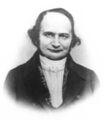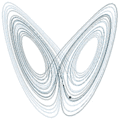Template:Selected anniversaries/December 10: Difference between revisions
No edit summary |
No edit summary |
||
| Line 32: | Line 32: | ||
||1901 – The first Nobel Prizes are awarded. | ||1901 – The first Nobel Prizes are awarded. | ||
||Walter Henry Zinn | ||1906: Walter Henry Zinn born ... nuclear physicist who was the first director of the Argonne National Laboratory from 1946 to 1956. He worked at the Manhattan Project's Metallurgical Laboratory during World War II, and supervised the construction of Chicago Pile-1, the world’s first nuclear reactor, which went critical on December 2, 1942, at the University of Chicago. At Argonne he designed and built several new reactors, including Experimental Breeder Reactor I, the first nuclear reactor to produce electric power, which went live on December 20, 1951. Pic. | ||
||1907 | ||1907: The worst night of the Brown Dog riots in London, when 1,000 medical students clash with 400 police officers over the existence of a memorial for animals that have been vivisected. | ||
||1934 | ||1920: Mathematician Alfred William Goldie born. He will work in ring theory where he introduced the notion of the uniform dimension of a module, and the reduced rank of a module. He is well known for Goldie's theorem, which characterizes right Goldie rings. Indeed, his Independent obituary described him as the "Lord of the Rings". Pic: http://www-history.mcs.st-and.ac.uk/Biographies/Goldie_Alfred.html | ||
||1934: Howard Martin Temin born ... geneticist and academic, Nobel Prize laureate. | |||
File:Chrome Plover early publicity photo.jpg|link=Chrome Plover|1959: [[Chrome Plover]], the famous [[musical electroplating ensemble]], demonstrates new controller units. | File:Chrome Plover early publicity photo.jpg|link=Chrome Plover|1959: [[Chrome Plover]], the famous [[musical electroplating ensemble]], demonstrates new controller units. | ||
||Oded Schramm | ||1961: Oded Schramm born ... mathematician known for the invention of the Schramm–Loewner evolution (SLE) and for working at the intersection of conformal field theory and probability theory. Pic. | ||
||Gnome | ||1961: Nuclear weapon test Gnome is detonated, with a yield of 3.1 kilotons. https://en.wikipedia.org/wiki/Project_Gnome | ||
File:Gasbuggy Nuclear device.jpg|link=Project Gasbuggy (nonfiction)|1967: [[Project Gasbuggy (nonfiction)|Project Gasbuggy]] underground nuclear test detonation in rural northern New Mexico. Its purpose was to determine if nuclear explosions could be useful in fracturing rock formations for natural gas extraction. | File:Gasbuggy Nuclear device.jpg|link=Project Gasbuggy (nonfiction)|1967: [[Project Gasbuggy (nonfiction)|Project Gasbuggy]] underground nuclear test detonation in rural northern New Mexico. Its purpose was to determine if nuclear explosions could be useful in fracturing rock formations for natural gas extraction. | ||
||1968 | ||1968: Japan's biggest heist, the still-unsolved "300 million yen robbery", is carried out in Tokyo. | ||
||1973 – Wolf V. Vishniac, German-American microbiologist and academic (b. 1922) | ||1973 – Wolf V. Vishniac, German-American microbiologist and academic (b. 1922) | ||
Revision as of 17:01, 25 August 2018
1198: Polymath Ibn Rushd (Averoess) dies. He wrote on logic, Aristotelian and Islamic philosophy, theology, the Maliki school of Islamic jurisprudence, psychology, political and Andalusian classical music theory, geography, mathematics, and the mediæval sciences of medicine, astronomy, physics, and celestial mechanics.
1452: Mathematician, astronomer, astrologer, priest, maker of astronomical instruments, and professor Johannes Stöffler born.
1684: Isaac Newton's derivation of Kepler's laws from his theory of gravity, contained in the paper De motu corporum in gyrum, is read to the Royal Society by Edmond Halley.
1804: Mathematician and academic Carl Gustav Jacob Jacobi born. He will make fundamental contributions to elliptic functions, dynamics, differential equations, and number theory.
1815: Mathematician and writer Ada Lovelace born. She will do pioneering work in symbolic languages for machine processes, developing what will later be called computer programs for Charles Babbage's early mechanical general-purpose computer, the Analytical Engine.
1831: Physicist and academic Thomas Johann Seebeck dies. He discovered the thermoelectric effect.
1959: Chrome Plover, the famous musical electroplating ensemble, demonstrates new controller units.
1967: Project Gasbuggy underground nuclear test detonation in rural northern New Mexico. Its purpose was to determine if nuclear explosions could be useful in fracturing rock formations for natural gas extraction.
1989: Animated Lorenz system diagram celebrates the life and work of Ada Lovelace.
2014: The Eel receives news from informants.









